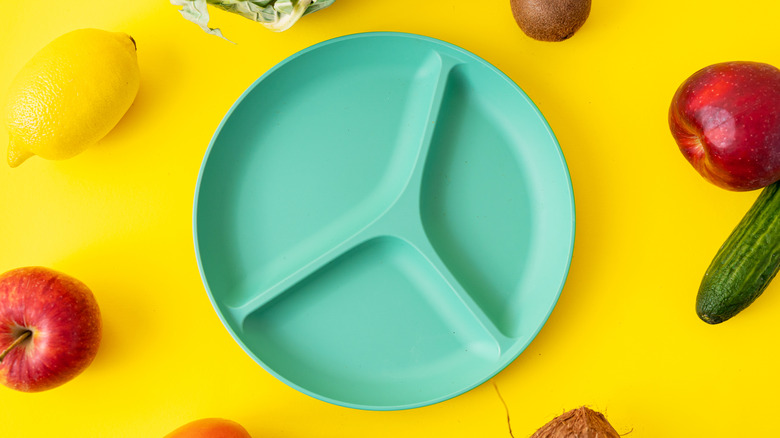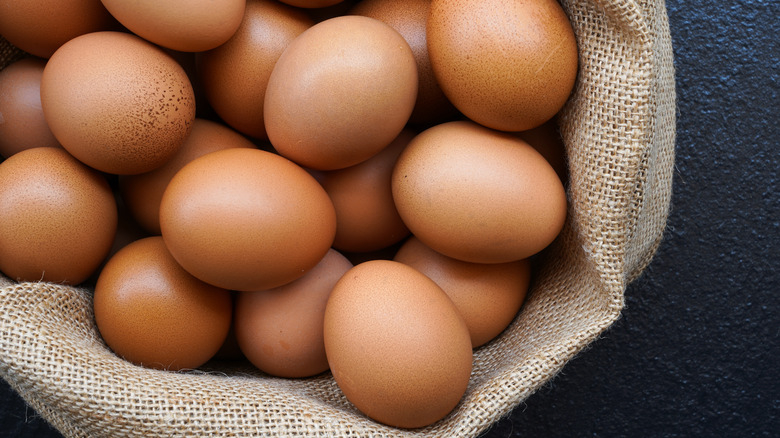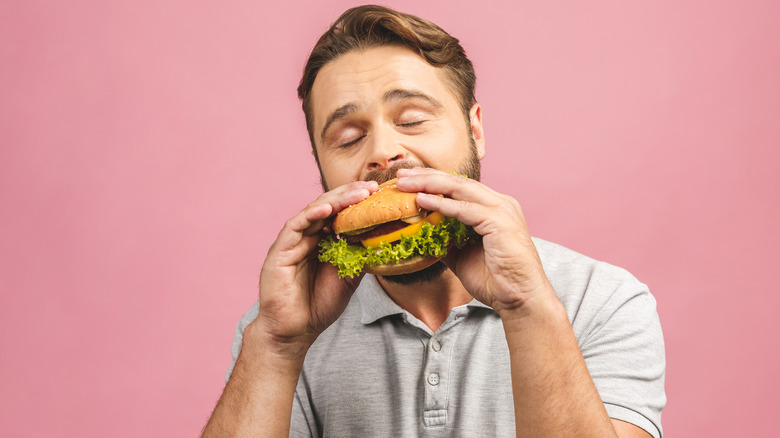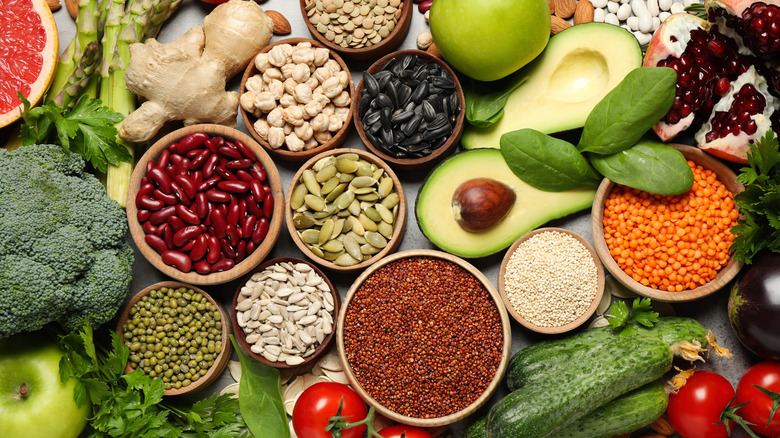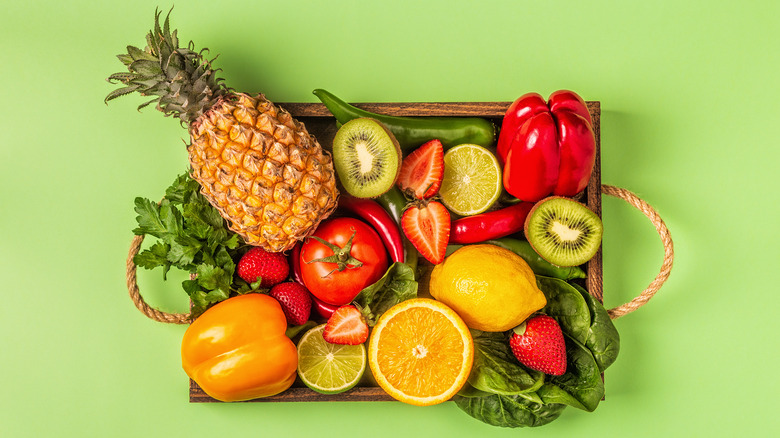What You Should Know Before Starting An Elimination Diet
Many people have food allergies and diet-related inflammation. In fact, according to Healthline, 2 to 20% of people worldwide may have a food intolerance of some kind. Pursuing an elimination diet with fairly strict rules is a great way to help identify food-related triggers that cause inflammatory conditions.
With so many people struggling with skin conditions, gastrointestinal distress, and more, it seems like elimination diets would be at the forefront of wellness culture. While some wellness coaches are wising up to the benefits that food journals and elimination diets can provide, elimination diets aren't regularly discussed in the mainstream. However, allergists and registered dietitians alike have been using this unique tool to identify food sensitivities in their patients (via Women's Health).
Elimination diets remain one of the best ways to identify adverse reactions to specific foods. Not only that, but elimination diets can help relieve many uncomfortable side effects of diet-related inflammation when done properly. However, as Healthline cautioned, you "should only try an elimination diet under the supervision of a medical professional."
What is an elimination diet?
At its core, an elimination diet is a strict food regimen that helps a person identify what foods their body can — and cannot — tolerate well. Elimination diets have two main phases: elimination and reintroduction (via Healthline).
The inflammatory foods list is full of obvious offenders, such as tree nuts, dairy, soy, and wheat. Additionally, some of the foods that are often eliminated are known to be healthy but can cause inflammation in some bodies, like coffee, corn, alcohol, shellfish, and eggs (via Women's Health). It is important to note that although these foods cause reactions in some people, they do not cause a reaction in everyone.
An elimination diet may seem overly strict, but remember it is a temporary tool. It should only be performed in an effort to identify food triggers. In this way, the term "diet" is a total misnomer (via Women's Health).
Who should try an elimination diet?
Inflammation and food sensitivities can present in many different ways. For example, your dairy sensitivity may present as gastrointestinal distress, while someone else's may manifest in a rash (via Healthline). But no matter how your sensitivities appear, you may find relief and improvements in your health when following an elimination diet.
Your doctor or dietitian may recommend an elimination diet if you have irritable bowel syndrome, which affects 10 to 15% of people worldwide (via Healthline). This diet may also be prescribed if you have eosinophilic esophagitis, a chronic condition in which allergies cause inflammation of the esophagus. Elimination diets may even be recommended to help you manage attention-deficit/hyperactivity disorder (ADHD), migraines, or eczema, Healthline detailed.
While adults can safely follow an elimination diet under the supervision of a medical expert, the same cannot. be said for children. "Elimination diets restrict many essential nutrients that are important for growing children, and long-term restriction could stunt their growth," Healthline confirmed. As such, you should never put your child on this diet unless specifically directed by their pediatrician.
Understanding the two main phases of an elimination diet
There are a few different types of elimination diets, but they all have a few commonalities, according to Healthline. Most notably, two main phases need to be executed with precision to obtain accurate results: elimination and reintroduction. The best way to start an elimination diet is to keep eating as you normally do but to keep a food journal, registered dietitian Maxine Yeung told Women's Health. By keeping track of what you eat and how you feel after each meal, you can start to identify triggers before the dirty work begins.
Elimination: The true first phase, the elimination portion, can look different depending on what you assume your triggers to be and the guidance of your medical professional (via Women's Health). This is the part where you take out any potential food triggers. You will likely be advised to eliminate all potential triggers and food groups at the same time.
Reintroduction: Depending on the plan you have put into action, you could stay in the elimination phase for four to eights weeks (via Healthline). After that, you will begin the reintroduction phase. During the reintroduction phase, you will, predictably and systematically, reintroduce the foods that you have eliminated. It's important to only reintroduce one food at any one time. This phase is best executed with a strict eye for detail and a food journal on hand (via Women's Health).
An elimination diet will change your eating habits dramatically
While calling an elimination diet a "diet" may conjure archaic images of the cabbage soup diet or the dreaded grapefruit diet, you should not start an elimination diet with the intention of losing weight (via Women's Health). Simply put, it is better to think of an elimination diet in more medicinal terms.
At first, the elimination phase of the diet will likely be a dramatic change. You will jettison various food groups from your day-to-day life, which can be totally jarring. As you move through the weeks of elimination, you will notice that the changes in your diet will omit a lot of convenience foods — this is why it is so important to plan ahead during this phase, according to Women's Health.
As you start to reintroduce foods, you are likely to encounter a food (or foods) that causes adverse reactions in your body. Once you identify these triggers, you will be able to build a new diet around this information. For example, if homemade mac 'n cheese is a go-to dinner in your household and you find out that cheese triggers you, you will need to creatively swap out the pesky lactose-rich ingredients. While this may sound daunting on the surface, it is absolutely worth it in the name of good health!
It isn't easy, at least not at first
Eliminating foods from your diet is not entirely easy. In fact, you might find yourself struggling to stick with the plan. In an interview with Well+Good, Dr. Aviva Romm, a physician specializing in integrative medicine, explained that it can be helpful to reframe the way you look at an elimination diet, focusing on "replacement" as opposed to "restriction." She encourages those who pursue an elimination diet to ensure that they are not eating less food overall, as that can make you not only tired of the diet but physically tired as well. The goal is not to restrict calories, but to simply suss out the foods that might be causing a sensitivity.
Dr. Romm further advised incorporating healthy fats, fiber, and protein, as these will aid in keeping your energy up. She added that everyone should acknowledge that the first five days of an elimination diet will likely be tough. The main reason people struggle throughout these first days is because their bodies are so accustomed to consuming sugar and carb-heavy foods as sources of quick fuel. With much of those options taken off the table, your body will need to recalibrate to create energy as you move forward.
Some forms of carbohydrates may be omitted from your lifestyle as you start your elimination diet. However, it is important to remember that elimination diets are not low-carb "diets."
Your bowel habits may change on an elimination diet
Bowel movements are the great equalizer when it comes to conversation topics and, honestly, one of our favorite things to talk about (don't judge). As you begin your elimination diet journey, your bowel movements may change due to what you are putting into your body.
According to Everyday Health, eliminating carbs cause bloating and constipation, and eliminating gluten can lead to diarrhea because of the changes in the amount and kind of fiber consumed. Yes, it is highly likely that you'll experience one bathroom-related swing or another depending on which food groups you set aside.
Of course, experts do not recommend long-term dietary changes of this caliber, as GI troubles can persist. Unless it is medically necessary to engage in a lifelong '"free-from" diet, Tamara Duker Freuman, a registered dietitian, encourages you to think twice as you may only end up feeling worse than before you start (via Everyday Health).
One must reintroduce foods safely and slowly
Identifying food allergies and sensitivities is the main reason one would embark on a journey as harrowing as an elimination diet. If you already know that you have a true food allergy that sends you into anaphylaxis, you should, of course, avoid consuming or testing that known food trigger (via WebMD). If you have food allergy symptoms, using an elimination diet as a tool to identify the problematic foods may be the right choice for you, but you should consult your doctor first.
Once you begin the reintroduction phase of your elimination diet, well, s*** starts to get real — literally and figuratively. As you systematically reintroduce one food at a time, it is important to be aware of what's happening to your body and write down how you feel after eating, explained WebMD.
When reintroducing foods back into your diet, you do risk an allergic reaction. If you experience throat swelling, trouble breathing, or immediate rashes or hives, get emergency medical help ASAP. Milder reactions to foods can include gastrointestinal issues, headaches, and slower-onset skin conditions. "If your symptoms disappear after you stop eating a specific food or ingredient, your doctor should order blood or skin tests to confirm the food allergy diagnosis," advised WebMD. "Some, but not all, food allergies can be diagnosed this way."
It takes work to ensure you're getting proper nutrition
As highlighted, it is important to follow an elimination diet under the supervision of a dietitian or a doctor. This is mostly to ensure that your nutritional requirements are being met (via Women's Health).
As you begin your elimination diet, you will likely eliminate a few categories of whole, healthy foods. This list can include any foods that you are suspicious of in your diet (via WebMD). Additionally, you may be advised to omit many food additives (think: food dyes and artificial sweeteners) as they are known to trigger reactions in some people.
This is yet another reason planning is key. If you start by bypassing eggs, meat, milk, gluten, barley, rye, shellfish, and soy, it's not a stretch to say you'll likely come up short in the nutrient department. By planning ahead and following the counsel of a medical professional, you will be able to satisfy your nutritional needs during the course of the elimination phase (via WebMD).
What can you eat on an elimination diet?
While the idea of an elimination diet can be daunting, there are plenty of included foods that will keep you full and happy. From nuts and seeds to avocados and tons of veggies, the meal options are endless and accessible with a bit of planning (via WebMD).
You may find it easiest to begin your meal planning with a grain such as rice or quinoa — as long as you are not eliminating grains. Of course, what you will be able to eat in the elimination phase will vary depending on the style of elimination diet you choose and who is overseeing your progress.
It is important to ensure a balance of carbohydrates, fats, and proteins. This is best accomplished by eating a colorful variety of fruits and veggies, lean meats, and healthy grains. And remember, you aren't eliminating water! Hydration is a key component that should not be overlooked (via WebMD).
Should you continue to eat fruits and veggies?
Fruits and vegetables are undeniably healthy. Adults are advised to consume about 2 cups of fruit and 2 to 3 cups of vegetables per day (via CDC). However, depending on the elimination diet your medical team recommends, you may have to avoid some fruits and veggies for a time.
Citrus fruits are known to grow a mold within their rinds that can cause a reaction in some people, according to Verywell Health. Furthermore, nightshade vegetables (tomatoes, potatoes, peppers, eggplant) contain a small number of alkaloids. This is a nitrogen-containing compound that can affect people in many different ways (via WebMD). As registered dietitian Ryanne Lachman explained to the Cleveland Clinic, "If nightshades are a trigger for inflammation, it's typically a message that there is an underlying imbalance perpetuating chronic, low levels of inflammation, and nightshades are just fuel for the fire."
Elimination diets are not without certain risks
Elimination diets are a helpful tool and often used in a holistic capacity to help people identify foods that may be causing adverse reactions within their bodies. But elimination diets come with a set of risks. Namely, elimination diets and children are a combination that should be approached with extreme caution and medical care. Dietary restrictions can also have harmful effects on pregnant and lactating women, a study published in the Annals of Internal Medicine revealed.
Furthermore, elimination diets have been known to trigger so-called "latent" eating disorders, "Food Allergy" explained (via Science Direct). This happens because it draws a person's relationship with food from casual to serious. The excess monitoring of foods and food groups may not be healthy in individuals at risk for disordered eating. The book further encourages practitioners who prescribe elimination diets to consider the socioeconomic implications of elimination diets as well. Often, the cost of swapping out regular food items can be prohibitive.
If you are struggling with an eating disorder, or know someone who is, help is available. Visit the National Eating Disorders Association website or contact NEDA's Live Helpline at 1-800-931-2237. You can also receive 24/7 Crisis Support via text (send NEDA to 741-741).

